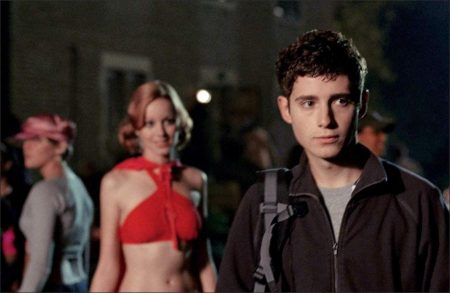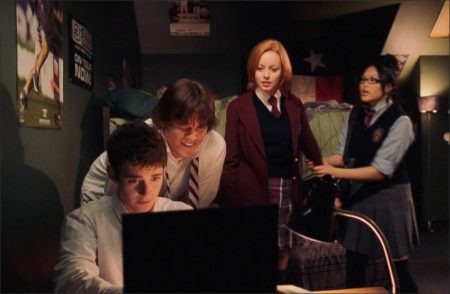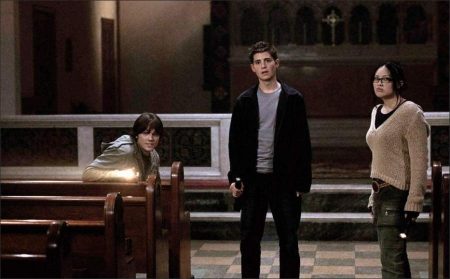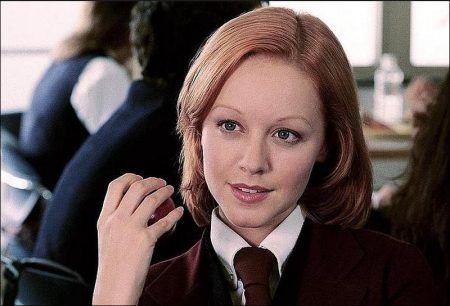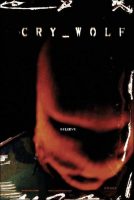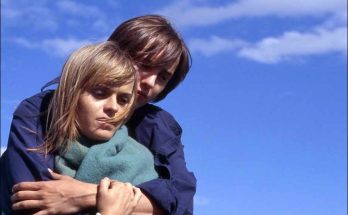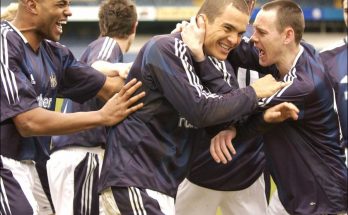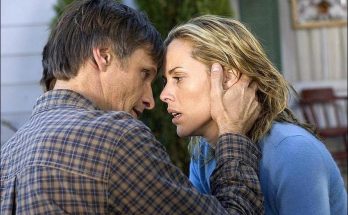Cry_Wolf Movie Trailer. Sandra Demarest arrives at the Caldwell estate, and announces to Mark Caldwell that she was secretly married to his nephew James, who recently died. Mark does not believe her, but allows her to remain at the manor while a search is made for a missing will that would prove her claim. Sandra befriends James’ sister, Julie, who tells of strange noises and agonized screams from the laboratory wing of the estate. Between verbal duels with Mark, Sandra secretly investigates the lab and learns that ominous things really are happening.
Interview with Jeff Wadlow & Beau Bauman
Q: How did you hatch the Cry_Wolf concept together? Were there any specific thriller inspirations?
Jeff Wadlow: Not really; in fact, initially, we were going to adapt a play for the feature film leg of the Chrysler Million Dollar Film Festival competition. But the week we had to submit our idea, the playwright got cold feet and we lost the rights. With the clock ticking, I went out for a run and came up with the idea for a liars’ club that incites the wrath of a real killer when they fake an eyewitness report.
Beau Bauman: A recreational liars’ club – basically Fight Club, with lies.
JW: As opposed to the other contestants, who had at least a draft or a treatment of their scripts already written, Beau and I now had only two weeks to write an entire feature screenplay from scratch.
BB: Jeff wanted to play with the idea of a modern-day retelling of Aesop’s “The Boy Who Cried Wolf” fable. Originally, it was set among twentysomethings in L.A. and was called Living the Lie.
JW: For the competition, we shot a five-minute presentation piece starring Topher Grace and Estella Warren – which will hopefully be on the Cry_Wolf DVD – before pitching to a live audience at the Toronto Film Festival. The contest judges liked it enough to award me the top prize, but then we had to survive the development process.
We were counseled to make the characters younger and take the story out of L.A. Although it took us months to figure out how to make that happen while keeping the core story in place, we soon agreed that it was ultimately the right thing to do – and something we would have probably figured out on our own if we hadn’t written the first draft in fourteen days.
BB: Though the execution of the initial screenplay was imperfect, we were still passionate about the idea of telling a story about liars and exploring the themes of truthand- lies. Doug Liman, who executive-produced Cry_Wolf, was the one who suggested setting it in high school. So we wrote new treatments and outlines, and several dozen different drafts…
JW: Although the subsequent rewrite was so different that we felt compelled to change the title to Cry_Wolf, the script we shot still retained the seeds of what excited us about the original concept; a movie that mixes film noir conventions with the conventions of the teen thriller/horror genre to play on preconceived notions of subjectivity and take an audience on a smart and scary ride.
BB: Initially, we tried to do everything we could to distinguish ourselves from the Wes Craven model, but ultimately found ourselves embracing certain established genre conventions because – let’s face it – they work.
But ours is not a typical teen thriller; it’s driven by smarter characters that don’t do obviously stupid things. There are no times when the audience will be yelling at the screen, “You idiot! Don’t open that door. Get out of the house!” We were relentless about asking ourselves, “What would we do?” The crew would laugh as Jeff and I had heated arguments about what we would actually do in the unlikely event that we were being chased by a crazed killer.
JW: Even from the trailer, it’s clear that Cry_Wolf owes something to Scream and Urban Legend. It’s important to remember though, that Scream came out in 1996 and that cycle of films was part of a much longer evolution of the genre. Our hope is that Cry_Wolf will ultimately be seen as a small step in that cycle.
BB: After self-awareness had turned to parody, hardcore slashers made a comeback with films like the remake of Texas Chainsaw. In our film, there is zero campiness, no winking or nodding. However, our characters have certainly seen all of those movies. In the writing process, Jeff and I talked about what the key elements were for an iconic killer, much like Owen and Dodger do in the movie. We wanted to create something that fans could emulate for Halloween, and “The Wolf’s” wardrobe is something anybody can buy anywhere – orange ski mask and camouflage jacket.
JW: When we set out to make our movie, we tried to identify genre conventions we liked – and the ones that had grown stale. As the script evolved, we tried to figure out ways to incorporate our favorites while also flipping clichés on their head. We were also really inspired and influenced by a pre-existing party game called Mafia.
BB: Our editor and associate producer Seth Gordon first introduced us to it, and we soon learned that there is a real underground subculture of people who play this game obsessively. We adapted it for our film because it was a game that rewarded lying and worked really well as a thematic metaphor for the story.
Q: You have some surprises layered into the storytelling. How did you work them in; did you start with them and then write around them?
JW: Some of the surprises were reverse-engineered. We did this by figuring out where we wanted to be at a certain point in the script, and then plotting it out backwards from there. But other plot twists came about while we were trying to take the script in one direction, only to realize that it made a lot more sense to go in the other. No matter how we arrived at a surprise in the story, we were always meticulous about making sure it would hold up if you watched the film a second time. Nobody likes a cheater.
Q: How did you come to cast your lead actors?
JW: It was important to us that we have actors who looked like they were in high school, as we all felt that the 29-year-old actor playing a 12th-grader was a big reason why the teen thriller had grown a little stale. We saw literally hundreds of actors over a twomonth period of casting the film, and our casting director Fern Champion saw even more than we did.
BB: Fern discovered Cameron Diaz and cast her in The Mask; she also cast Beverly Hills 90210 and several Friday the 13th movies – hence, she’s familiar with the teen genre as well as making discoveries. So we thought it was ambitious, but not totally unreasonable, to give her the mandate of finding an ensemble of kids who one day people will be astonished to realize that they all once starred in the same movie.
JW: For the main character of Owen Matthews, we were looking for someone unique. Owen is supposed to be savvy but also possesses a tendency for getting into trouble.
BB: He is the boy who cries wolf. So he had to have a boyish mischievousness to him.
JW: Almost every actor we saw was either too tough or too vulnerable, and we needed a balance of both. I was also looking for someone with experience, since Owen is onscreen for well over 90% of Cry_Wolf.
BB: He’s the audience’s surrogate. The actor playing Owen had to have the chops to carry the movie on his back. We looked for months.
JW: As soon as Julian Morris walked in the door, we knew we had our guy. From his experience in the Royal Shakespeare Company to his James Dean-like qualities, we could not have asked for a better Owen Matthews.
BB: Even though Julian can don a flawless American accent, we thought his natural accent would help the character be perceived as even more of an outsider, and of course it’s also appealing to women. Those are the moments when casting is really exciting; as a writer, it’s the first time you’re seeing and hearing the words and the character come to life.
JW: I saw tape on Jared Padalecki from Gilmore Girls very early on, when we were looking for our Owen. I honestly thought he was way too funny to play Owen, who is more serious. Fern told me I was crazy because he is on his way to becoming a huge star and that we’d be lucky to have him, but I stood my ground. After his manager told us that we had hurt Jared’s feelings because we were seeing every other actor in town I agreed to read him for Tom. Well, Fern was right; he knocked it out of the park at the audition.
BB: We thought Jared’s stature and humor would work for Tom, and his classic good looks would be emblematic of the blueblood traditions at Westlake.
JW: It was that seamless mix of the class clown with the school jock that not only made Jared perfect for the role of Tom – he made Tom a better role.
BB: He was the first actor we cast.
JW: We probably read more actors for the role of Dodger than all the others combined. We needed to find a young woman charismatic enough to lead an elite boarding school’s cleverest clique, yet still accessible enough to fall hard for the new kid. After an exhaustive search in both L.A. and N.Y., we actually gave up.
BB: We even looked at pop stars in Miami and supermodels in Europe. But still, in our minds, nobody we read at that point was Dodger.
JW: So we just headed to Virginia to start prepping the shoot without knowing what we were going to do about Dodger. Things were pretty bleak, until one of our mentors, Universal Pictures executive Jeff LaPlante, recommended a Canadian actress whose work he admired in Dawn of the Dead. Since Beau and I had to fly to the Toronto Film Festival anyway – for the announcement of the next Chrysler Million Dollar Film Festival winner – we decided to read a couple of actresses up North.
BB: Just before Lindy Booth’s audition, Jeff and I had a heart-to-heart at a pizza place in Toronto, where we surrendered our dream of finding the perfect Dodger. We were convinced that we’d have to compromise, and settle for an actress who had at most seven or eight of the ten qualities we were looking for…then, thirty minutes later we met Lindy Booth, who actually possessed twelve.
JW: I wish we had taped Lindy’s audition, because it was the finest acting we had seen since we began the casting process. Beau was so sure that Lindy was right for Dodger, and so nervous that I might feel otherwise, that he couldn’t even look at me as she left the room. Not that it mattered – I was already chasing her down the hall to ask her if she could swim; otherwise, we were going to have to rewrite the pool sequence…
Q: She’s been in a couple of thrillers, but Lindy’s role in Cry Wolf isn’t the typical one for a female in a horror movie; was this a conscious effort on your part and/or Lindy’s?
JW: I’m not sure it was a conscious decision so much as it was a reality of the movies Beau and I like and the movie we want to make. I’m not interested in victims or villains; every person believes they are the hero of their own story, and I think it’s important to see each of your characters through that filter.
I always describe Dodger as one of the girls I had a crush on in high school. I was never interested in the pretty and popular types who were voted “best eyes.” I liked the girls who did their own thing and were voted “most likely to succeed.”
BB: Lindy not only delivered everything we were looking for, she brought things to the part that none of us expected.
Q: The movie utilizes a traditional thriller setting, a school campus. Did you shoot at a real one?
JW: We shot the movie in Richmond, Virginia. In terms of production and creative needs, we found everything we were looking for in Richmond. The Virginia Film Office, and the residents of Richmond, rallied behind our little film from the beginning. They supported us in ways I can’t imagine any other film commission or community could. Local restaurants and businesses donated food and supplies; our crew accomplished feats that were seemingly impossible on our budget; and locations invited us onto their property and allowed us to interrupt their lives – without complaint.
BB: People gave their blood, sweat, and tears to this film – not for money, but to help a hometown boy make good –
JW: I was born and raised in Virginia.
BB: We can’t wait to make more movies there. Their production center has an incredible crew base and talented actors. Our unit production manager and location manager Oriana Robertson did a tremendous job, and the film commission used the full weight of their office on our behalf. In addition to beautiful foliage, Virginia has a delicate balance of rural locations and urban convenience.
JW: For the school, I wanted a traditional gothic campus that looked like it was nestled in the middle of nowhere. This was important because the major motive for why our characters do what they do is boredom and the lengths that they will go to in order to escape it.
BB: It was also a conscious decision to set the story at a boarding school, so it would be self-contained. The kids can’t go home to their parents at the end of the day; and they can’t run to the police if there isn’t anything other than campus security for miles. You can tell the audience all of this, but it’s so much more powerful if you show them.
JW: The audience needed to feel isolated by the wilderness and overwhelmed by the beauty of the architecture. The University of Richmond fit the bill, and the support we received from the students and faculty – and, in particular, Carla Shriner, our liaison – allowed us to achieve far more than we had any reasonable hope of accomplishing.
BB: Though we shot at various schools, seminaries, and institutions in and around Richmond, almost all of the main iconic footage was shot at U of R. The University’s campus feels like an idyllic place of tradition and privilege, and helps set the tone of Owen becoming enamored with this new world. The themes of the film revolve around contrasts – between fiction and reality, between right and wrong, and specifically between classic and contemporary. The cast wears traditional ties and blazers, but personalizes their appearances with modern flourishes; the campus has grand gothic redbrick architecture, yet inside they also have labs stocked with brand new computers.
We brought the actors to Virginia over a week early, partially to rehearse and partially to bond. We had this naïve fantasy about a “film camp” atmosphere, with the cast living and rehearsing and playing together. Thing is, it actually worked – and the group chemistry is evident in the movie. The actors became very close; they’re all still friends, a few are now roommates, and some of them are even dating each other.
Q: What were some specific challenges you each faced once you were actually in production?
JW: The biggest challenge for me as a director was how to continue to be creative, given the logistical challenges that I was facing. We had set out to shoot a script that our mentors – at Universal Pictures’ physical production department – had told us they would have budgeted at $15-20 million…and we had $1 million.
BB: Having no money – that was the biggest challenge. During pre-production, my outgoing voice mail greeting was, “Hi, this is Beau Bauman. If you’re calling to ask for more money, the answer is ‘No.’”
JW: Since there was no margin for error, I would plan every scene down to the smallest detail with editor Seth Gordon, DP Romeo Tirone, and script supervisor Kristin Calabrese.
Unfortunately – or, fortunately, depending on how you look at it – something went wrong almost every day. These problems would cause me to amend the day’s game plan and improvise; by having to figure out ways to simplify a scene, combine locations, or simply find a different camera angle, the material was elevated in ways I could not have imagined. For me, the toughest days were the ones when everything was going well but nothing felt right. On those occasions I would try to take a step back and think about the movie I would want to see as a moviegoer, as opposed to the film I was trying to make as a director.
BB: There was daily disaster aversion and general crisis management. This included, but was not limited to: a helicopter without a proper camera mount running out of gas racing against an oncoming storm on the one day the pilot was available; the power shorting out every time we tried to turn the lights on at the pool location, taking away half a day of shooting; trying to find the flashlights that firemen use, which turn out to be made by only three companies in the world, and then getting them donated; working around a hurricane that forced our entire production office to take over the nearest Kinko’s after our power and phones were lost for over a week; rearranging the shooting schedule multiple times due to thunderstorms and/or cast availability; trying to keep Jon Bon Jovi’s presence hidden from the press, for security reasons; casting Gary Cole from across the country, the day before shooting his scenes; using available light to shoot a 2-page scene in under 1 hour; shooting in a moving bus – as it was breaking down; running out of film on a Friday night, with a shoot scheduled for Saturday morning; handling a Chrysler PT convertible that, at the time, was 1 of only 2 in existence; having car accidents with borrowed vehicles; using free FedEx envelopes as interoffice envelopes, in order to save money on office supplies; filming active cell phones in areas with no cell service; and keeping actual high school students on-set as extras, after parents showed up to enforce their curfews.
All that, plus – how do you achieve aerial photography, underwater photography, crowd scenes, an ensemble cast, night exteriors, and shoot on film, all for $1 million? Well, we did, thanks in large part to the tremendous support of vendors such as Panavision, Technicolor, and Efilm – who all got behind the spirit of the Chrysler competition to support first-time filmmakers to an unprecedented extent. Also, with the help of Gina Crane, our product placement specialist, we made very aggressive efforts to add additional resources to the production.
Q: How integral was the IM and e-mail angle to the concept? It’s something we haven’t seen as a thriller storyline’s motivation?
BB: Our killer had to threaten the kids somehow…but pasted letters torn from magazines and filter-disguised phone calls felt so stale. So we asked ourselves, “What’s next?” The answer was, something electronic. With so many forms of communication out there these days, we had lots of options.
JW: There is something undeniably scary about the internet, chat rooms, instant messaging, etc. We’re getting so familiar with it, yet at the end of the day, you really have no idea who are you are talking to and where they are – especially given the advent of handheld wireless devices. It’s fertile ground; hopefully we were able to pull off successfully mining IM and the internet for scares.
BB: As the script developed, we realized that this was something people were responding to. So we pushed it a bit further, like with the camera phones. AOL was a big supporter from early on.
Q: But there now is a game that’s going to be out with the movie?
JW: Yes, it’s based on the lying game that the characters play in the movie and it’s being carried by AOL Instant Messenger. The fact that it’s actually happening is due in large part to Beau, who had the vision to pursue it relentlessly, long before we had distribution in place. There’s also an AIM mobile game that you can play on your phone, before the official online game is launched.
BB: The idea was originally to educate people about the game and engender some popularity before the movie comes out, so that watching the movie’s “game scenes” would seem less foreign. I had an initial idea of a game called “IM A Killer,” of which the pun was the best part. We weren’t sure it would work, but then Seth Gordon sat down and figured out the nuts and bolts of it.
AOL immediately responded to the idea of a proprietary game for AIM. They saw the film before anyone else, and hired Klear Games – an award-winning development company – to build the game. The AIM version is still a lying game of bluffing, suspicion, and accusation – very faithful to the game that’s played face-to-face in the movie, and totally addictive.
Rogue Pictures has really kicked things into high gear, and with the help of Chrysler and AIM Mobile, there’s going to be a huge contest called “The Hunt,” which will culminate in a massive scavenger hunt with a new Chrysler as the grand prize. “The Hunt” is what’s known as a “Big Game,” similar to Flash Mobs in that they use wireless devices to send clues and track players, effectively turning major cities into vast game boards. It should be very cool, and I’m more than a little bit jealous that they won’t let me play.
Q: And what should audiences expect from this movie when they buy their tickets and settle down to watch it?
JW: Cry_Wolf plays with some established conventions of the genre, and I hope that audiences will find it fresh – because it’s one of the few mainstream films out there that doesn’t talk down to its audience.
BB: The film should keep them guessing from start to finish. Whatever they expect, my biggest hope is that they’re surprised.
Cry_Wolf (2005)
Directed by: Jeff Wadlow
Starring: Julian Morris, Lindy Booth, Jared Padalecki, Jon Bon Jovi, Ethan Cohn, Sandra McCoy, Sabrina Gilbert, Shauna Sauls, Jesse Janzen, Paul James, Jane Beard, Gary Cole
Screenplay by: Beau Bauman, Jeff Wadlow
Production Design by: Martina Buckley
Cinematography by Romeo Tirone
Film Editing by: Seth Gordon
Costume Design by: Alysia Raycraft
Set Decoration by: Angela Ratliff
Art Direction by: Julie Smith
Music by: Michael Wandmacher
MPAA Rating: PG-13 for violence, terror, disturbing images, language, sexuality and a brief drug reference.
Distributed by: Rogue Pictures
Release Date: September 23, 2005
Views: 76
